How to cook a vegan feast for Easter lunch
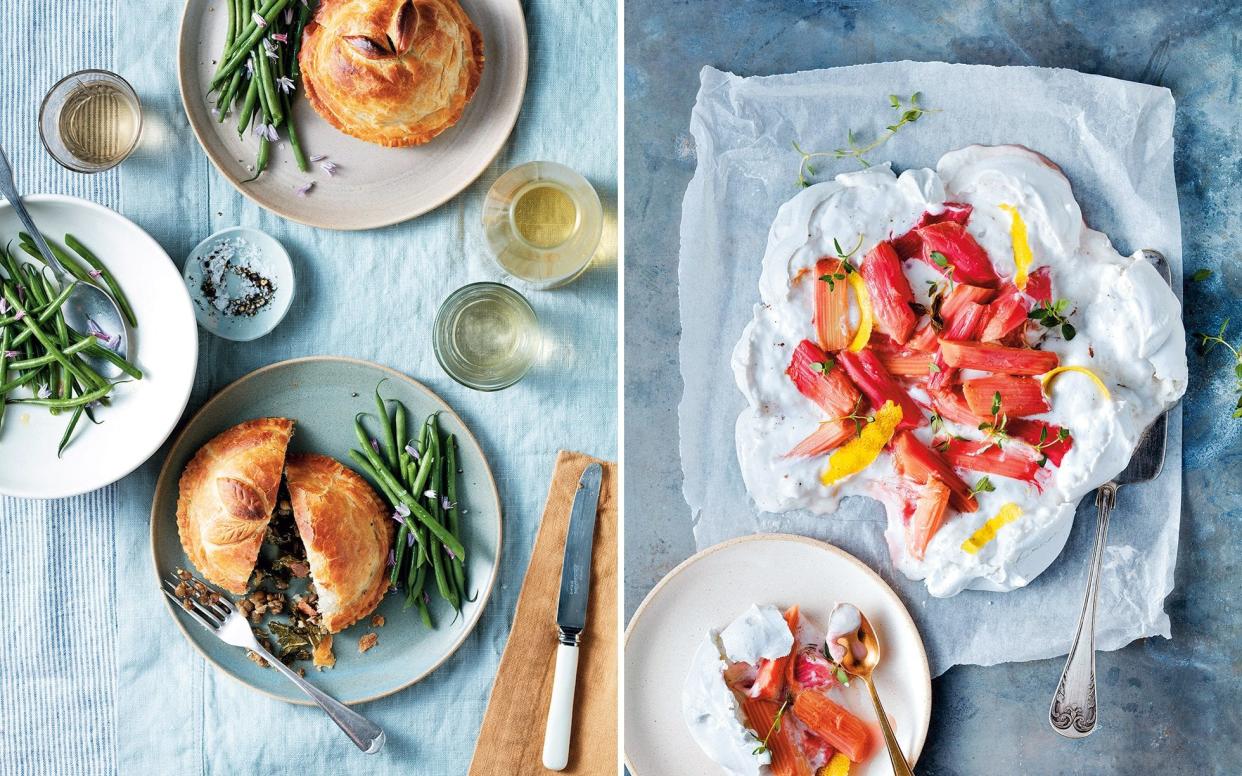
An Easter feast may seem a daunting prospect if you’ve just turned vegan. As Lent draws to a close and abstainers from chocolate, meat and alcohol anticipate breaking their fast with a clutch of foil-wrapped eggs and a glass of bright-fruited merlot alongside their roast leg of lamb, those pursuing a plant-based diet might find options at the table wanting. All those butter-rich cakes, and eggs, chocolate or otherwise…
The best approach if you’re hosting an Easter get together, says Aine Carlin, is to steer clear of replacing the starter or centrepiece roast dish for dish. ‘Instead I go for lots of smaller options that people can share and help themselves to,’ she advises. ‘Get some great dips on the table, serve up some substantial grains, throw in dishes to create your own menu.’
It relieves the pressure of having to tick all the traditional boxes, and for the food writer, who decided to turn vegan overnight eight years ago, it’s an approach that forms the basis of her new book, Cook Share Eat Vegan.
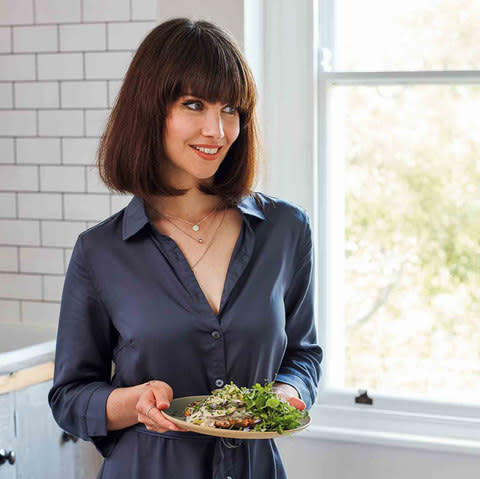
Look at the Easter menu with an open mind, she says, and it’s not hard to offer something for all tastes – from earthy spelt given a lick of sweetness by roasted grapes, to rich mushroom parcels made with dairy-free, shop-bought puff pastry. ‘Vegan dishes have so often missed out vital textural contrasts,’ Carlin says. ‘So bring into play toasted nuts, and balance flavours with sweet and savoury notes so that each mouthful delivers something different.’
There’s good news for the sweet-toothed, too, with pudding inspiration coming from the back of the kitchen cupboard. ‘I understand how off-putting it can be to have to hunt down xanthan gum or tapioca starch,’ she says of the ingredients often used in ‘free-from’ cookery.
‘I just reach for the whole food that I have in my kitchen.’ That includes the chickpea water, or aquafaba, that plays a starring role in Carlin’s egg-free pavlova. ‘I’ve tried making the recipe with liquid sugars but they didn’t really work. Instead it’s a bizarre thing that happens with the liquid drained from a tin of chickpeas – and the finished thing really doesn’t taste of them!’ It’s time to serve up a spread that satisfies – and might just surprise you, too.
Aquafaba | The vegan's best friend
Cook Share Eat Vegan is published by Octopus (£20). To order your copy for £16.99 plus p&p, call 0844-871 1514 or visit books.telegraph.co.uk
Spelt salad with roasted cauliflower and grapes
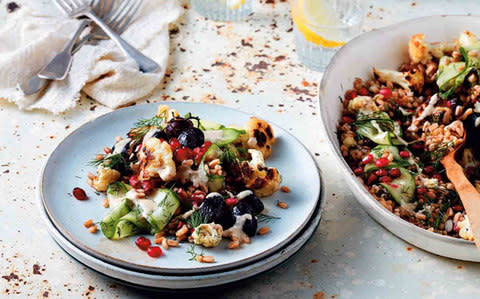
I adore this wonderful grain. If you have never roasted grapes before, you’ll be surprised by how magnificent they are all blistered and bruised and bursting with flavour.
SERVES
4
INGREDIENTS
200g spelt grains, soaked overnight and rinsed
½ large cucumber, cut into ribbons
2 tbsp cider vinegar
1 tbsp agave nectar
½ tsp sea-salt flakes small bunch of dill, finely chopped, plus extra torn fronds to serve
handful of pomegranate seeds, to garnish
For the roasted cauliflower and grapes
1 small head of cauliflower, broken into florets
1 tbsp olive oil
1 heaped tsp zaatar (or dried thyme)
50g seedless black grapes
For the dressing
75g sunflower seeds
1 tsp Dijon mustard
juice of ½ lemon
½ tsp pomegranate molasses
½ tbsp agave nectar or maple syrup
sea-salt flakes, to season
METHOD
Add the spelt grains to a large saucepan and pour over 750ml water. Cover and bring to the boil, then reduce the heat to a simmer and cook for 60-75 minutes, or until all the liquid has been absorbed. Remove from the heat and leave to steam, covered, for 5-10 minutes, then fluff the grains up with a fork and set aside to cool completely.
Preheat the oven to 220C/gas mark 7.
Put the cauliflower florets in a bowl with the olive oil, toss to coat and sprinkle over the zaatar. Season generously, arrange on a baking tray in an even layer and roast for 15 minutes, then add the grapes and roast for a further five minutes, or until the cauliflower is lightly charred and the grapes are blistered.
Meanwhile, put the cucumber ribbons in a bowl. Whisk the cider vinegar, agave nectar and sea-salt flakes together in a separate bowl, then pour over the cucumber ribbons and set them aside for 15-20 minutes to pickle lightly.
Place the cooled spelt in a shallow serving bowl together with a tablespoon or so of the cucumber-pickling liquid. Drain the cucumber, add it to the bowl with the dill and toss everything together with your hands.
To make the dressing, place all the ingredients in a blender with some black pepper, and blitz, adding 150-175ml water as needed, until completely smooth. Scrape down the sides from time to time as you go.
To serve, top the salad with the roasted cauliflower and grapes, drizzle over the dressing and garnish with the pomegranate seeds and a few torn dill fronds.
Hot lemony artichoke and spinach dip
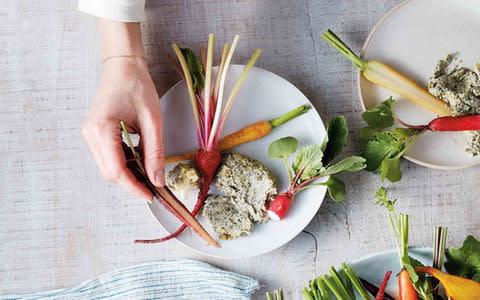
This is a nice departure from the usual hummus. The creaminess is the result of a terrific cashew-tofu combo, which sounds odd but totally works. The nutritional yeast is not crucial; it adds a certain ‘cheesiness’ that some people adore, but it’s not the deciding factor in the success of the dip.
SERVES
4
INGREDIENTS
200g cashew nuts, soaked and drained
½ tsp sea-salt flakes
grated zest and juice of 1 lemon
150g silken tofu
3 tbsp nutritional yeast (optional)
½ tbsp Dijon mustard
½ tbsp olive oil
150g baby-leaf spinach
150g pre-cooked artichokes
METHOD
Preheat the oven to 240C/gas mark 9.
Place the cashews in a blender with 150ml water, the sea-salt flakes, half a teaspoon of black pepper and half the lemon juice. Blend until smooth before adding the tofu, yeast (if using) and mustard. Season and blend on a high speed for 5-7 minutes, until completely smooth and pourable, scraping down the sides of the blender from time to time as you go.
Heat the olive oil in a pan over a low-medium heat, add the spinach and cook for 1-2 minutes, or until gently wilted. Transfer to a blender together with the artichokes and lemon zest, season and pulse to combine. Pour in 250ml of the cashew and tofu cream, along with the remaining lemon juice, season generously and pulse until the mixture just comes together but still retains some texture. (Any leftover cashew and tofu cream will last for a week in the fridge, and can be used in pasta sauces, soups or layered in lasagne, or as a topping for nachos.)
Transfer to a baking dish and bake for 20 minutes, until browned, then remove from the oven and leave to cool for a few minutes before serving. It’s great with crudités.
Individual mushroom Wellingtons
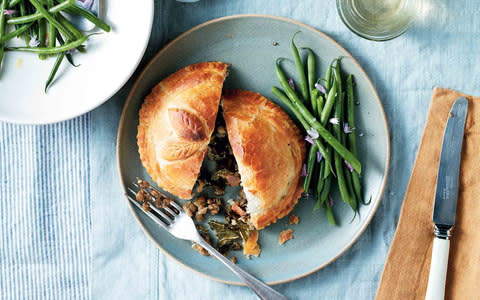
The trick here is to tuck the pastry tightly around the mushrooms, making sure there are no air bubbles, so that it shrinks as the mushrooms cook and reduce. Serve with steamed green beans and simply boiled salad potatoes.
SERVES
4
INGREDIENTS
2 tbsp olive oil
3 shallots, finely chopped
4 large garlic cloves, minced
200g green lentils, rinsed and drained
2 bay leaves
1 vegetable stock cube
1½ tsp Marmite
4 large portobello mushrooms, trimmed
100g kale, leaves torn and stems removed
juice of ½ lemon
2 sheets of vegan ready-made puff pastry, thawed if frozen
flour, for dusting
METHOD
Heat a tablespoon of the olive oil in a large saucepan over a medium heat. Add the shallots to the pan, season and sweat for 2-3 minutes, until translucent. Stir in the garlic and sauté for 1-2 minutes, then add the lentils, the bay leaves, 750ml water and the stock cube. Stir to dissolve the stock cube, bring to a gentle simmer and cook for 40 minutes, or until most of the liquid has been absorbed and the lentils are tender and almost cooked through.
Stir the Marmite through the lentils and simmer for a further 5-10 minutes, or until all the liquid has been absorbed. Remove from the heat and leave to cool, then spoon the mixture over the mushrooms. Set the lentil-stuffed mushrooms aside.
Heat the remaining olive oil in a frying pan over a medium heat. Add the torn kale, season generously and heat, stirring occasionally, until gently wilted. Squeeze over the lemon juice and set aside to cool.
Preheat the oven to 220C/gas mark 7.
Roll the pastry sheets out slightly on a floured work surface to enlarge each one by about a third, then use a saucer as a template to cut out eight pastry circles. Cut simple leaf-shaped decorations out of the excess pastry.
Place a small heap of kale in the centre of four pastry circles and lay a mushroom on top of each, lentil-stuffed-side down. Place the remaining pastry circles on top (rolling them out a little more first if you need to for fit) and pinch the sides together with a fork. Trim off any excess pastry and tuck in any gaps as you go, ensuring there are no air bubbles around the mushrooms.
Gently press two pastry leaves on to each Wellington and bake for 30-35 minutes, until golden and crisp. Leave to cool slightly before serving.
Vegan pavlova with poached rhubarb and vanilla yogurt
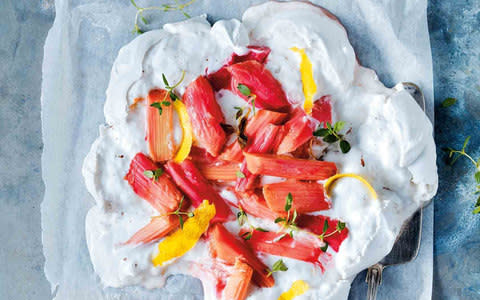
Pavlova – the holy grail of vegan desserts if ever there was one. Who would have thought that chickpea liquid would be the answer to our prayers? A stand mixer or electric mixer is pretty crucial here, and I advise whisking until the mixture is as firm as you can humanly get it before transferring it to the tray. It’s also crucial that you allow the meringue to cool completely in the oven before removing it. I like to make it a day in advance, but if you’re not serving it immediately, be sure to keep it in an airtight container. If you prefer to make slightly smaller meringues, reduce the cooking time by 30 minutes.
SERVES
6-8
INGREDIENTS
100ml chilled aquafaba (reserved chickpea liquid)
½ tsp cream of tartar
125g caster sugar
400ml coconut yogurt
1 vanilla pod, split lengthways and seeds scraped
400g rhubarb, cut diagonally into 6cm chunks
4 tbsp raw cane sugar
1 strip of lemon rind, plus extra to garnish
1 lemon-thyme sprig, plus extra to garnish
METHOD
Preheat the oven to 120C/gas mark ½. Line a large baking sheet with baking paper.
Place the aquafaba in a stand mixer with the whisk attachment added and whisk on a medium setting until it becomes thick and frothy. (Alternatively, a large mixing bowl and handheld electric whisk will work equally well, although it may be a little more tasking on the arms.)
Add the cream of tartar and whisk on a high setting for at least 10 minutes, until thick peaks begin to form. Gradually add the caster sugar, one tablespoon at a time, until the mixture is glossy and thick – this may take up to 30 minutes but it is crucial the mixture is as stiff as possible, so be patient.
Secure the baking paper on the sheet with a dot of meringue under each corner, then spoon over the meringue and shape it into a rough circle or rectangle using a spatula, spreading it out to almost meet the edges of the tray. Transfer to the oven and cook for three and a half hours, then turn off the heat and leave to cool completely in the oven for at least six hours, ideally overnight. Transfer to an airtight container until needed.
Whisk together the coconut yogurt and vanilla seeds (reserving the pod) to combine. Refrigerate until needed.
Place the rhubarb in a saucepan along with the cane sugar, lemon rind, thyme and vanilla pod. Pour over just enough water to cover (200-250ml), bring to a very gentle simmer and cook for 10-12 minutes, or until the rhubarb is just cooked through. Leave it to cool in the syrup, then refrigerate for several hours, or until needed.
To assemble, layer the coconut yogurt over the meringue, followed by the rhubarb, and garnish with lemon rind and thyme.

